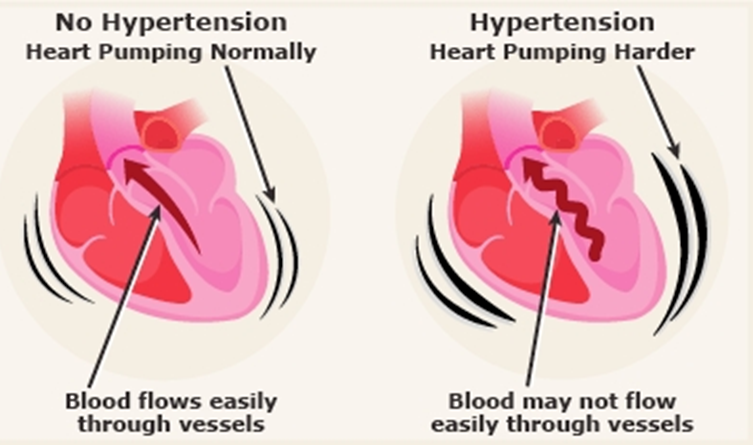A client with nasal congestion receives a prescription for phenylephrine 10 mg PO every 4 hours. Which client condition should the nurse report to the healthcare provider before administering the medication?
Bronchitis.
Diarrhea.
Hypertension.
Edema.
The Correct Answer is C
Choice A Reason:
Bronchitis is a condition that affects the respiratory system, and while it is important to monitor, it is not a primary concern when administering phenylephrine. Phenylephrine is a decongestant that works by narrowing the blood vessels in the nasal passages, which can help relieve congestion but does not directly impact bronchitis.
Choice B Reason:
Diarrhea is a gastrointestinal condition that, while uncomfortable, does not significantly interact with phenylephrine. It is important to manage and monitor, but it does not pose a direct risk when taking phenylephrine.
Choice C Reason:
Hypertension is a significant concern when administering phenylephrine. Phenylephrine can increase blood pressure by causing vasoconstriction. For clients with hypertension, this can exacerbate their condition and lead to serious cardiovascular complications. Therefore, it is crucial to report this condition to the healthcare provider before administering the medication.

Choice D Reason:
Edema, or swelling, can be a symptom of various underlying conditions, including heart failure or kidney issues. While it is important to monitor, it is not as directly impacted by phenylephrine as hypertension. However, any underlying condition causing edema should be considered when administering medications.
Nursing Test Bank
Naxlex Comprehensive Predictor Exams
Related Questions
Correct Answer is D
Explanation
Choice A Reason:
Polyuria, or excessive urination, is a symptom of diabetes insipidus rather than a side effect of vasopressin. Vasopressin is used to reduce urine output in DI patients. If polyuria persists, it may indicate that the medication is not effective, but it is not a direct side effect that requires immediate reporting.
Choice B Reason:
Low urine specific gravity indicates dilute urine, which is a characteristic of diabetes insipidus. Vasopressin should help concentrate the urine. If low urine specific gravity persists, it may suggest that the medication is not working effectively, but it is not a side effect that necessitates urgent reporting.
Choice C Reason:
Polydipsia, or excessive thirst, is another symptom of diabetes insipidus. While vasopressin should help reduce this symptom by controlling urine output, persistent polydipsia may indicate inadequate treatment. However, it is not a side effect of the medication that requires immediate attention.
Choice D Reason:
Worsening headache is a significant side effect that should be reported to the healthcare provider. Headaches can indicate water intoxication or hyponatremia (low sodium levels), which are serious complications of vasopressin therapy. Immediate reporting is necessary to adjust the treatment and prevent further complications.
Correct Answer is D
Explanation
Choice A Reason:
Antiretroviral medications are effective in decreasing AIDS-related complications. These medications work by reducing the viral load in the body, which helps to maintain the immune system and prevent the progression of HIV to AIDS. By keeping the viral load low, the risk of opportunistic infections and other complications associated with AIDS is significantly reduced.
Choice B Reason:
One of the primary goals of antiretroviral therapy (ART) is to decrease the viral load to an undetectable level. When the viral load is undetectable, it means that the amount of HIV in the blood is so low that it cannot be detected by standard laboratory tests. Achieving and maintaining an undetectable viral load is crucial for the health of the individual and helps to prevent the progression of the disease.
Choice C Reason:
It is important to understand that while antiretroviral therapy can control HIV infection and reduce the viral load to undetectable levels, it does not cure the infection. HIV remains in the body, and if the medication is stopped, the viral load will increase again. Continuous adherence to the medication regimen is necessary to keep the virus under control and maintain health.
Choice D Reason:
While antiretroviral therapy significantly reduces the risk of HIV transmission, it does not completely prevent it. The concept of “undetectable = untransmittable” (U=U) means that individuals with an undetectable viral load have effectively no risk of transmitting the virus through sex7. However, it is still important to use other preventive measures, such as condoms, to further reduce the risk of transmission.
Whether you are a student looking to ace your exams or a practicing nurse seeking to enhance your expertise , our nursing education contents will empower you with the confidence and competence to make a difference in the lives of patients and become a respected leader in the healthcare field.
Visit Naxlex, invest in your future and unlock endless possibilities with our unparalleled nursing education contents today
Report Wrong Answer on the Current Question
Do you disagree with the answer? If yes, what is your expected answer? Explain.
Kindly be descriptive with the issue you are facing.
